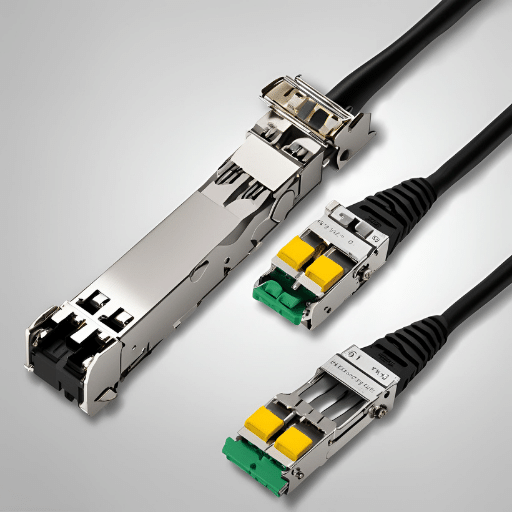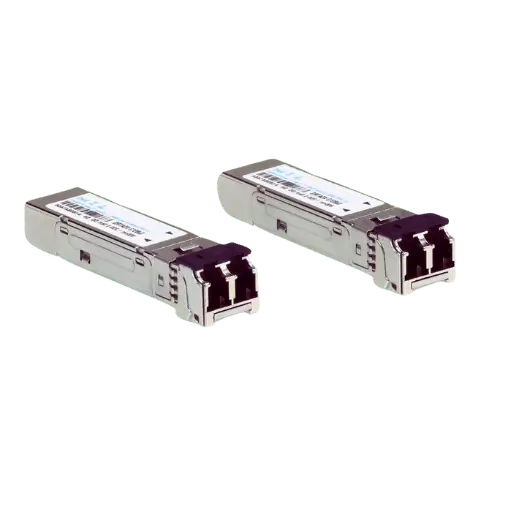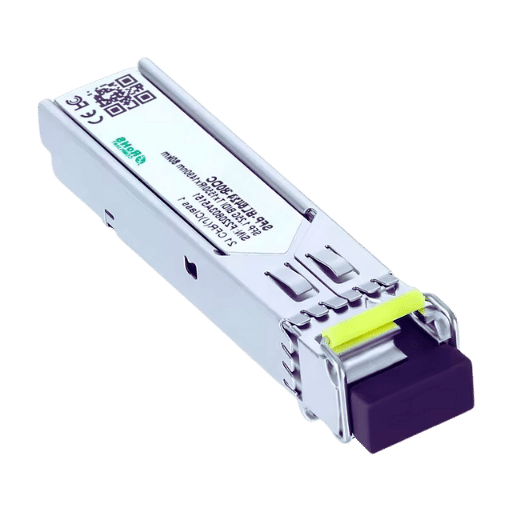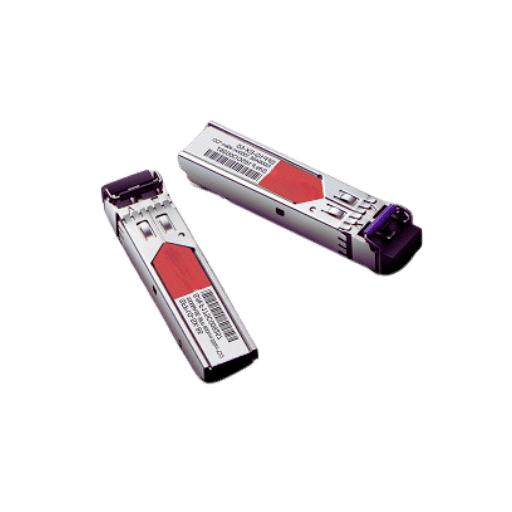The two primary categories of Fiber Optic Technology are Single-Mode (SM) and Multimode (MM) Small-Form-Factor Pluggable (SFP) transceivers. SFP modules serve as a crucial element in network communication by allowing a network device to interface with either a fiber optic or copper networking cable.
Single-mode SFP modules are designed for long-distance transmission, typically exceeding 10 kilometers. Such modules use a thin fiber optic cable diameter that allows only one mode of light to pass through the fiber straight, thereby reducing signal attenuation and enabling higher bandwidth capacity. This makes them ideal for telecommunication applications and carrier networks.
Conversely, multimode SFP modules have been designed for short-distance transmissions, usually up to 550 meters at 10 Gbps networks, and utilize wider fiber optic cables. This enables numerous modes or light paths to be transmitted along the fiber, making it suitable for high data rates over short distances. MM SFPs primarily find applications in enterprise and data center environments.
When selecting between single-mode and multimode SFP modules, one must understand the network’s specific needs, such as distance, data rate, and budgetary constraints. This directly affects the overall efficiency, performance, and scalability of the fiber-optic infrastructure.

The primary difference between single-mode SFP (SM SFP) and Multimode SFP (MM SFP) transceivers is in their optical wavelength, transmission distance, and the type of optic fiber to which they are targeted. SM SFP transceivers are made for long distances, using a thin strand of fiber to send only one light wave that can go over 10 km. This is essential for wide network applications covering vast geographical areas, such as citywide telecommunication and international data exchange. On the other hand, MM SFPs are designed for shorter distances ranging between 550m or less while employing a broader optic fiber that can allow for multiple light paths. They are thus ideal for internal high-speed communications within localized networks like those found in data centers and LANs. Ultimately, whether a network uses MM or SM short-form pluggables depends on how far it needs to transmit its signal and at what speed it wants this done; all these should be done within the realms of budgetary constraints of the infrastructure’s scale and scope.
When comparing Single Mode Fiber (SMF) with Multimode Fiber (MMF), several key parameters must be examined to understand their distinct capabilities and applications:
To sum up, the choice between SMF and MMF will depend upon a careful evaluation of the specific network requirements including desired transmission distance, bandwidth needs, cost considerations as well as the physical environment in which the fiber is intended to be deployed. Each of these types of fibers have unique benefits that make them applicable in varied types of telecommunications and data transmission industry.
The importance of optical transceiver wavelengths in telecommunications and networking cannot be exaggerated. These wavelengths, which are essentially light colors that the fiber carries, have a critical impact on data transmission, its capacity, distance, and compatibility. For long-haul transmissions, longer wavelengths around 1550 nm are preferred because they attenuate less, allowing signals to travel over long distances without signal loss. Conversely, for short-range applications such as those found within the data center environment, shorter wavelengths may be used owing to their cost-effective nature and high data transmission speeds. Also, when certain wavelengths are chosen, there is the ability to use Dense Wavelength Division Multiplexing (DWDM), which is a technology that enhances the amount of data a fiber can carry by allowing various signals operating at different wavelengths to be transmitted simultaneously along one common fiber-optic cable. This understanding forms the basis for designing efficient and flexible communication networks that are pocket-friendly.
Distance is important in determining the benefits of single-mode fiber (SMF) compared to multimode fiber (MMF) for a telecommunication network that spans a vast geographical area. In terms of distance coverage, single-mode fiber provides unmatched advantages, which are essential to telecommunications networks covering large geographic areas. This is in contrast to MMFs which are mainly used for shorter distances because of their tendency for modal dispersion; SMFs can transmit up to 100 kilometers without signal regeneration requirements. It is the core’s small diameter, around 9 micrometers, that enables this capacity. It allows only one mode of light to propagate, thus significantly reducing dispersion and maintaining signal integrity over longer distances. With reference to this feature, the following applications are advantageous.
Besides distance, Single Mode Fiber also allows advanced technologies like DWDM hence its ability to handle massive amounts of data traffic simultaneously increases. This makes SMF an integral part of modern telecommunications infrastructure due to its combination of high capacity, reliability and distance coverage.
Single-Mode Fiber SFP (Small Form-factor Pluggable) modules are designed to be used with single-mode fiber optic networks. These SFP modules are widely recognized for being able to transmit data very fast and over long distances, making them ideal in stated applications such as long-distance communication, metropolitan area networks, and high-speed broadband access. The reason why single-mode SFPs work well with SMFs can be attributed to their designs that conform with the core diameter and mode of transmission specific to single mode fibers. Such a precise alignment ensures negligible signal loss as well as dispersion over long distances. Additionally, by integrating single-mode SFP modules into telecom infrastructure, they make it possible for networks to support Dense Wavelength Division Multiplexing (DWDM) technology. This is important because it allows the network to increase its capacity when handling increased data traffic through amplification, thus enabling the simultaneous transmission of large quantities of information on a single optical fiber without impairing the integrity or quality of the signal. Single Mode SFP Modules are highly compatible and reliable, providing significant improvements in performance, which makes them indispensable for realizing sophisticated high-capacity fiber optic networks.

In general, small form-factor pluggable (SFP) modules in a multimode are cheaper than those in single mode since the amount of materials and costs spent to manufacture them is less. In a multimode fiber optic cable, the light source is aligned to the fiber by the use of a wider core diameter, which simplifies the process. This reduces both manufacturing precision requirements and LED costs for multimode SFPs. Additionally, these cost savings are achieved through liberal waveguide building standards as well as fewer rigorously done coatings. All in all, this makes it possible for such short-reach applications as data centers to have more reasonable prices relative to long-haul communications, including interconnection between office buildings and transmission of high data rates over short distances.
Multimode SFP modules are highly suitable for high-speed data transmission in shorter distances. The following main applications can be called perfect scenarios to utilize multimode SFP.
These uses benefit from lower-priced yet acceptable performance over short connections associated with these devices, thus making them ideal for equipment linking within the same campus or nearby locations. Alternatively, single-mode SFP modules would be more suitable for long-haul links, relying on their higher initial cost but better range and bandwidth characteristics.

When looking at single-mode and multimode SFP (Small Form-factor Pluggable) modules, the main differences are in wavelength and signal transmission capabilities. Single-mode fiber makes use of a smaller core that is typically about 9 micrometers wide; hence, they can send signals for long distances—sometimes as much as one hundred kilometers for some modules because they rely on only one light mode, resulting in minimal signal attenuation and dispersion over distances.
On the other hand, multimode fibers have larger cores with diameters of approximately 50-62.5 micrometers to enable carrying several light modes. However, this also implies that the mode dispersion results in diminishing quality of signal with distance; hence, effective transmission is limited to shorter distances, typically less than 2km.
Thus, core diameter influences the wavelength range used by these modules: single-mode SFPs usually work at 1310 or 1550nm that is suitable for long-distance links while multimodality SFPs usually operate at 850 nm which is good for their operating range. Therefore, choosing between single-mode and multimode SFP modules often depends on specific requirements of an application such as distance and bandwidth demanded or even pricing issues.
Single mode or multimode SFP modules? It depends on your network’s bandwidth and distance, and that is why you need to choose between single-mode and multimode SFP modules. Single-mode SFP devices are the perfect choice for long-range communication purposes because they allow transmitting data over tens of kilometers or even hundreds of kilometers without any significant signal loss. Such kinds of networks include metropolitan area networks (MANs), campus networks, or generally any long-haul networking where there is a high requirement in throughputs and the least signal losses.
On the other hand, multimode SFP modules will do best for shorter-distance applications, e.g., within data centers or within buildings/computer rooms/campuses where very fast data transfer is needed over relatively short distances. These types of environments are well served by these fibers due to their low cost when compared to others with similar features.
Therefore, whether one goes for a single-mode or multi-mode SFP module will depend on the exact length covered by the transmission of information as well as its required speed. Despite its higher initial investment costs, which translates into greater break-even points, single-mode is optimal in this case, considering its long-distance high-speed requirements, while multimode can be used as a cost-effective alternative for shorter distances with applications that require huge bandwidth.
The design and operation of a network must take into account the compatibility of single-mode and multimode fibers. Single mode and multimode fibers do not have equivalent designs that enable them to be used interchangeably, which causes possible deterioration in signal quality as well as transmission efficiency. The latter has a small core diameter, ideally around 9 micrometers, that allows only one pathway of light propagation, thereby minimizing signal loss or dispersion over long distances. On the other hand, the former has a large core diameter with sizes ranging from 50 to 62.5 micrometers that supports multiple modes or light paths.
Direct links between single-mode and multimode fibers are incompatible because when light enters a multimode fiber from a single-mode fiber, there may be too much coupling loss, reducing the power level and quality of the signal. Consequently, one must carefully choose the type of fiber for each particular application to ensure optimal performance. A range of specific interconnect technologies, including mode conditioning cables or media converters, is sometimes deployed to bridge connections between single mode and multimode settings; however, this choice comes at an increased cost and complexity.

Three factors are crucial when examining network requirements for the choice between single mode and multimode SFP (Small Form-factor Pluggable) modules: distance, speed, and cost.
With these parameters understood by network designers and administrators can help them make informed choices that meet current needs while preparing for the future. To achieve optimum network performance and scalability one has to strike a balance between distance speed and cost tradeoffs.
The SFP (Small Form-factor Pluggable) module that is carefully chosen must be the correct one. Physical and technical compatibility between the fiber types used for a module is crucial when choosing a suitable patch cord. Initially, it is important to match the fiber mode of patch cords, which may be either single mode or multimode, with the SFP module to ensure signal integrity and optimal performance. Single-mode fibers are usually used in long-distance SFP modules because they can transmit signals over longer distances without any significant losses, whereas multimode fibers are able to support shorter high-speed connections on SFP modules.
Besides, attention should be paid to the connector type, such as LC, SC, or ST, that is utilized by a fiber optic patch cord and an SFP module. The connector has to fit into the interface of the module physically and should offer secure connections with minimum loss. Moreover, selecting patch cords that perform well above current network requirements will enable them to accommodate further improvements and faster data rates in order to future-proof and scale networks.
To sum up, the alignment of fiber type, connector compatibility, and performance parameters of patch cords with specifications for SFP modules forms the basis for efficient and reliable network infrastructure, enabling smooth data transmission while minimizing possible connectivity glitches.
Many principles will contribute towards a successful and reliable installation of SFP modules, depending on whether you are working with single-mode or multimode fibers. The first thing is to check compatibility between your module and fiber, specifically focusing on the wavelength requirements and design distance for your network. Inspection of connectors on both ends of the link, as well as cleaning the ports of the SFP before connecting, helps to remove dust and contaminants that can cause signal degradation. As for single-mode installations, alignment is critical because they have small core diameters requiring extreme accuracy in order to avoid insertion losses. On the other hand, although there is more tolerance in multimode fiber connections due to their relatively large core sizes, cleanliness should be maintained at all times while considering what data rate/distance would require which grade, like OM3 or OM4, respectively. Always go by manufacturing guidelines for module insertion/removal that usually need a secure “click” type of mechanism that assures proper seating without over doing it. Finally, system-level tests after installation should be carried out to ascertain the functioning status of the link and its performance against agreed benchmarks required for the transmission of data and integrity of networks. Following these recommendations will contribute toward long life and dependability in fiber optic communication networks.
The analysis is presented by Fiber Optic Magazine, and it involves comparing the technical specifications and performance differences between single-mode and multimode SFP modules. The article also disaggregates the main features that will enable a reader to choose wisely on which optical fiber product can work for his or her network.
An academic journal publication in the Journal of Optical Networking explores the applications, advantages, and practical considerations of using single-mode and multimode SFP transceivers in optical networking environments. Such research provides insights into many technicalities about this subject for industry professionals as well as academicians.
On the OptiTech Solutions website, there is an all-encompassing guide on how to select a proper type of SFP module with the benefits of single-mode vs. multi-mode included. Users get practical recommendations from the manufacturer source that help in understanding which type of fiber optics will suit their network infrastructure most.
These selected sources deliver valuable knowledge about differentiating criteria for single-mode versus multi-mode SFP modules, allowing people who want to ascertain the most appropriate optic solution for their networking setups. Single mode has been broken down by Fiber Optic Magazine while Journal of Optical Networking presents academic exploration and OptiTech Solutions provides pragmatic guidance; all these sources contain accurate information from which readers can make decisions based on specifications on whether to go with SMF or MMF SFPs

A: The chief difference lies in the kind of fiber optic they are made for. A single-mode SFP (small form-factor pluggable) is developed to function in a single-mode fiber that only allows one mode of light to pass through, making it suitable for long-distance transmission. In contrast, a multimode SFP is constructed for multimode fibers that support multiple modes of light and is perfect for short-distance transmissions. Moreover, the single-mode sfp module has a narrower laser wavelength, which is usually 1310nm or 1550nm, as compared to the multimode sfp module, which operates at 850nm wavelength.
A: Usually, this is not recommended as the small core size for single mode sfp makes it impossible to be used with multimode fiber, which has a larger core size. Using Single mode sfp in Multimode can result in signal loss and reduced quality of transmitted information due to mismatched core sizes. However, there are exceptions where by it may function with some performance penalty.
A: Both Single-Mode SFP And Multimode SFP Modules have similar physical form factors and can fit on the same SFP port found on switches or routers. However, while an optic patch cord used with SMF will always be yellow, MMF cables will appear orange or aqua, depending on their type. They have different internal optics and laser types optimized for each type of fiber they are intended to work with.
A: Generally, Single-Mode SFP Modules Are More Expensive Than Multimode Ones Because Of The Long Distance Technology And Raw Materials. Single mode fiber supports a higher bandwidth over long distances, which requires more precise and expensive laser technology. Besides, single-mode systems need lesser amplification at longer distances hence they have extra value and cost.
A: It is not recommended to use a multimode sfp in a single-mode fiber network because of the differences in core size and light propagation inherent in the two fiber types. The module uses multimode fiber that has short wavelengths and high dispersion; these features are incompatible with a single light path or narrow core of SMF. This mismatch can lead to poor signal quality or complete transmission failure.
A: The choice of either single-mode or multi-mode SFP will depend on the distance requirements and budget. If you want to transmit over long distances that exceed 500 meters away, then it is advisable to use a single-mode sfp since it can hold high data rates and can reach very far without signal loss. Multimode sfp modules could be used in short-range applications, normally below 500 meters, due to its economic benefits. Further, you may have to consider your current network infrastructure so as not to interfere with the system.
A: Yes, one good thing about single-mode SFP modules is that they are hot-swappable and compatible with standard SFP ports found in most networking hardware. This allows fast integration with existing systems that might already have other types of fiber optic interface cards installed, like multi-mode fibers. It is, however, important to note that the other end of the connection must also support the SMF interface for proper working and best performance.
A: The primary use areas for such kinds of modules include long-haul telecommunications within cities or across campuses where data is transmitted kilometers apart with minimum signal loss. Short-range applications such as in data centers for intra-building connections or even within a campus requiring high data rates over limited distances often prefer using multimode sfp modules. Both types are optimized for their particular uses, ensuring that data transmission efficiency is achieved each time.